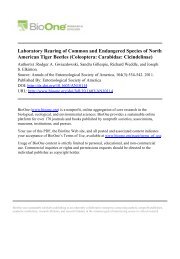Building Models from Experimental Data. - elkintonlab
Building Models from Experimental Data. - elkintonlab
Building Models from Experimental Data. - elkintonlab
You also want an ePaper? Increase the reach of your titles
YUMPU automatically turns print PDFs into web optimized ePapers that Google loves.
Pathogen-Driven Outbreaks Revisited 119<br />
Literature Cited<br />
Anderson, R. M., and R. M. May. 1980. Infectious diseases<br />
and population-cycles of forest insects. Science (Washington,<br />
D.C.) 210:658–661.<br />
———. 1981. The population dynamics of microparasites<br />
and their invertebrate hosts. Philosophical Transactions<br />
of the Royal Society of London B, Biological Sciences<br />
291:451–524.<br />
Anderson, R. M., R. M. May, G. F. Medley, and A. Johnson.<br />
1986. A preliminary study of the transmission dynamics<br />
of the (HIV), the causative agent of AIDS. IMA Journal<br />
of Mathematics Applied in Medicine and Biology 3:<br />
229–263.<br />
Bonsall, M. B., H. C. J. Godfray, C. J. Briggs, and M. P.<br />
Hassell. 1999. Does host self-regulation increase the likelihood<br />
of insect-pathogen population cycles American<br />
Naturalist 153:228–235.<br />
Bowers, R. G., M. Begon, D. E. Hodgkinson. 1993. Hostpathogen<br />
population cycles in forest insects: lessons<br />
<strong>from</strong> simple-models reconsidered. Oikos 67:529–538.<br />
Briggs, C. J., and H. C. J. Godfray. 1996. Dynamics of<br />
insect-pathogen interactions in seasonal environments.<br />
Theoretical Population Biology 50:149.<br />
Briggs, C. J., R. S. Hails, N. D. Barlow, and H. C. J. Godfray.<br />
1995. The dynamics of insect-pathogen interactions.<br />
Pages 295–326 in B. T. Grenfell and A. P. Dobson, eds.<br />
Ecology of infectious diseases in natural populations.<br />
Cambridge University Press, Cambridge.<br />
Campbell, R. W. 1978. Some effects of gypsy moth density<br />
on rate of development, pupation time, and fecundity.<br />
Annals of the Entomological Society of America 71:<br />
442–448.<br />
Carter, M. R., F. W. Ravlin, and M. L. McManus. 1991.<br />
Changes in gypsy-moth (Lepidoptera: Lymantriidae) fecundity<br />
and male wing length resulting <strong>from</strong> defoliation.<br />
Environmental Entomology 21:1308–1318.<br />
Cory, J. S., R. S. Hails, and S. M. Sait. 1997. Baculovirus<br />
ecology. Pages 301–340 in L. K. Miller, ed. The baculoviruses.<br />
Plenum, New York.<br />
D’Amico, V., and J. S. Elkinton. 1995. Rainfall effects on<br />
transmission of gypsy-moth (Lepidoptera: Lymantriidae)<br />
nuclear polyhedrosis-virus. Environmental Entomology<br />
24:1144–1149.<br />
D’Amico, V., J. S. Elkinton, G. Dwyer, and J. P. Burand.<br />
1996. Virus transmission in gypsy moths is not a simply<br />
mass-action process. Ecology 77:201–206.<br />
D’Amico, V., J. S. Elkinton, G. Dwyer, R. B. Willis, and<br />
M. E. Montgomery. 1998. Foliage damage does not affect<br />
within-season transmission of an insect virus. Ecology<br />
79:1104–1110.<br />
Dushoff, J. 1999. Host heterogeneity and disease endemicity:<br />
a moment-based approach. Theoretical Population<br />
Biology 56:325–335.<br />
Dwyer, G. 1991. The effects of density, stage and spatial<br />
heterogeneity on the transmission of an insect virus.<br />
Ecology 72:559–574.<br />
Dwyer, G., and J. S. Elkinton. 1993. Using simple models<br />
to predict virus epizootics in gypsy moth populations.<br />
Journal of Animal Ecology 62:1–11.<br />
———. 1995. Host dispersal and the spatial spread of<br />
insect pathogens. Ecology 76:1262–1275.<br />
Dwyer, G., J. S. Elkinton, and J. P. Buonaccorsi. 1997. Host<br />
heterogeneity in susceptibility and disease dynamics:<br />
tests of a mathematical model. American Naturalist 150:<br />
685–707.<br />
Dwyer, G., J. Dushoff, J. S. Elkinton, J. P. Burand, and<br />
S. A. Levin. 2000. Host heterogeneity in susceptibility:<br />
lessons <strong>from</strong> an insect virus. In U. Dieckmann, ed. Virulence<br />
management. Springer, Berlin (in press).<br />
Elkinton, J. S., and A. M. Liebhold. 1990. Population dynamics<br />
of gypsy moth in North America. Annual Review<br />
of Entomology 35:571–596.<br />
Elkinton, J. S., W. M. Healy, J. P. Buonaccorsi, G. H. Boettner,<br />
A. M. Hazzard, H. R. Smith, and A. M. Leibhold.<br />
1996. Interactions among gypsy moths, white-footed<br />
mice, and acorns. Ecology 77:2332–2342.<br />
Ellner, S., and P. Turchin. 1995. Chaos in a noisy world:<br />
new methods and evidence <strong>from</strong> time-series analysis.<br />
American Naturalist 145:343–375.<br />
Elton, C. 1927. Animal ecology. Sidgwick Jackson, London.<br />
Evans, H. F., and P. F. Entwistle. 1987. Viral diseases. Pages<br />
257–322 in J. R. Fuxa and Y. Tanada, eds. Epizootiology<br />
of insect diseases. Wiley, New York.<br />
Fuxa, J. R., and A. R. Richter. 1992. Virulence and multigeneration<br />
passage of a nuclear polyhedrosis virus selected<br />
for an increased rate of vertical transmission. Biological<br />
Control 2:171–175.<br />
Gould, J. R., J. S. Elkinton, and W. E. Wallner. 1990. Density-dependent<br />
suppression of experimentally created<br />
gypsy-moth, Lymantria dispar (Lepidoptera: Lymantriidae)<br />
populations by natural enemies. Journal of Animal<br />
Ecology 59:169–184.<br />
Hassell, M. P., J. H. Lawton, and R. M. May. 1976. Patterns<br />
of dynamical behavior in single species populations.<br />
Journal of Animal Ecology 45:471–486.<br />
Hassell, M. P., R. M. May, S. W. Pacala, and P. L. Chesson.<br />
1991. The persistence of host-parasitoid associations in<br />
patchy environments. I. A general criterion. American<br />
Naturalist 138:568–583.<br />
Hunter, A. F., and G. Dwyer. 1998. Insect population explosions<br />
synthesized and dissected. Integrative Biology<br />
1:166–177.<br />
Hunter, A. F., and J. S. Elkinton. 1999. Interaction between



